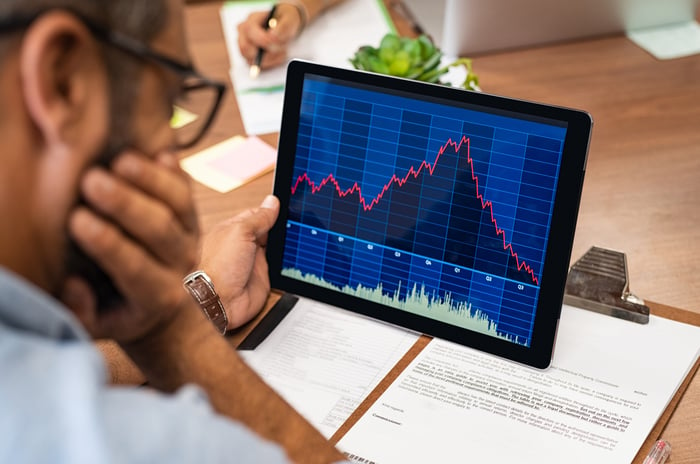Since this year began, the iconic Dow Jones Industrial Average, benchmark S&P 500, and growth-powered Nasdaq Composite have all put the 2022 bear market in the rearview mirror and catapulted to all-time closing highs. Although megacap stocks have done a lot of the heavy lifting, it's Wall Street's next-big-thing investment trend, artificial intelligence (AI), which is fueling this move.
When talking about AI, I'm referring to the software and systems being used in place of humans to carry out tasks. The secret sauce for AI is machine learning, which allows software and systems to learn over time and become more efficient at their tasks and/or learn new tasks.
The reason AI stocks have soared is simple: AI has application in almost every sector and industry. Though estimates vary wildly, the analysts at PwC believe artificial intelligence can add $15.7 trillion to global gross domestic product (GDP) by 2030.

Image source: Getty Images.
Nvidia has ridden its competitive advantages in AI to historic gains
No company has benefited more from the AI revolution than Nvidia (NVDA -0.57%).
When the curtain opened on 2023, Nvidia boasted a $360 billion market cap that had primarily been driven higher over the years by its dominance in graphics processing units (GPUs) used in gaming and cryptocurrency mining. As of the closing bell on March 4, 2024, Nvidia's market cap had swelled to $2.13 trillion. Only Apple and Microsoft stand in its way of becoming the largest publicly traded company.
Nvidia's skyrocketing stock is a reflection of its dominance as the infrastructure backbone of high-compute data centers. Its A100 and H100 GPUs are expected to account for the lion's share of GPUs deployed in enterprise-operated AI-accelerated data centers this year.
With demand absolutely overwhelming supply, Nvidia has enjoyed top-notch pricing power for its class-leading GPUs. Although production of its A100 and H100 GPUs is expected to increase this year as chip fabrication giant Taiwan Semiconductor Manufacturing expands its chip-on-wafer-on-substrate capacity, the bulk of Nvidia's data center sales growth has been driven by higher prices for the A100 and H100 supply it does have to offer.
But if things have seemed a bit too good to be true for Nvidia, history says they probably are.
History suggests AI and Nvidia are the latest in a string of next-big-thing bubbles
One of the few certainties Wall Street has to offer is that there's always a next-big-thing investment acting as a dangling carrot for opportunistic investors. Dating back 30 years, we've witnessed more than a half-dozen major investment trends that were expected to be game changers. While each and every one of these trends initially sent their respective stocks soaring, they all, eventually, came crashing back down.
- The advent of the internet revolutionized business across the board. However, the anticipated adoption of e-commerce and business-to-business commerce caused many dot-com stocks to implode between 1999 and 2002.
- Genome decoding has been steadily transforming the drug-development and disease-detection/prevention process for decades. But the exceptionally high costs of genome decoding in the late 1990s burst this bubble.
- Housing was an unstoppable force in the mid-2000s, with property values increasing at well over twice the rate of inflation. Unfortunately, poor lending standards from financial institutions, coupled with risky derivative investments, sunk this ship.
- China stocks were also on fire in the late 2000s, with investors expecting the world's No. 2 economy by GDP to sustain its outsized growth rate. However, most China stocks succumbed to poor internal controls and eventually tumbled.
- 3D printing was expected to be the hottest thing since sliced bread at the consumer level. But by the mid-2010s, it became apparent that 3D printer hype was mostly a fad.
- Cannabis stocks have shared a similar fate. Although U.S. cannabis sales have the potential to grow by a double-digit rate throughout the decade, marijuana remaining illicit on Capitol Hill has stifled profitability for the industry.
- Electric vehicles (EVs) looked like a slam-dunk investment, given the desire of developed countries to reduce their carbon footprints and combat climate change. Yet, we've witnessed a lack of adequate supporting infrastructure holding the EV industry back.
- Blockchain technology was expected to be the next big thing in banking that would ultimately weed out fraud, expedite cross-border transaction validation, and reduce fees. But as we've seen, broad-based blockchain utility has been hit-and-miss.
- The concept of the metaverse sent augmented and virtual reality stocks soaring in 2021. However, the sizable investments needed to develop 3D virtual worlds mean little immediate impact (i.e., sales) to the businesses focused on metaverse projects.
What all of these next-big-thing investments have in common is an overzealous investor base whose expectations for the uptake of a new innovation or trend simply didn't meet reality. Some investors might be tempted to proclaim that "this time is different" when it comes to artificial intelligence, but history suggests it's not.
Most businesses are still figuring out how they'll utilize AI to improve sales and bolster profits. Without concrete game plans, this looks like a recipe for AI uptake to eventually disappoint, just like every other next-big-thing investment before it over the past three decades.

Image source: Getty Images.
Headwinds are mounting for the infrastructure backbone of the AI movement
In addition to history not being on Nvidia's side, there are a number of headwinds the company is set to contend with this year.
One of the more ironic challenges for the infrastructure kingpin of the AI revolution is that increasing production of its A100 and H100 GPUs may be detrimental to its gross margin. Relatively modest increases in cost of revenue demonstrate that GPU scarcity powered its gross margin higher last year. As Nvidia increases its production, it'll be cannibalizing its own pricing power by limiting GPU scarcity.
Competition will also be coming at Nvidia from every direction. Traditional competitors like Advanced Micro Devices and Intel are rolling out AI-GPUs that will directly compete with Nvidia's chips in high-compute data centers.
But the bigger concern is the competition Nvidia is facing from within. The company's four largest customers by revenue (in no particular order) -- Microsoft, Meta Platforms, Amazon, and Alphabet -- make up roughly 40% of Nvidia's sales on a combined basis. All four of these juggernauts are developing AI chips of their own, which could lessen or remove their respective reliance on Nvidia's A100 and H100 GPUs.
U.S. regulators are doing Nvidia no favors, either. They've put their foot down on a couple of occasions and restricted exports of high-compute AI chips to China. Not being able to ship its top-of-the-line AI-GPUs to the world's No. 2 economy may cost Nvidia billions in lost revenue each quarter.
Lastly, the valuation doesn't make as much sense as some investors might think. While its price-to-earnings-growth ratio (PEG ratio) suggests the company is priced reasonably, Nvidia is currently valued at 38 times trailing-12-month (TTM) sales. With the exception of the dot-com peaks for Amazon and Cisco Systems, which both lasted for mere days and topped out at around 40 and 38 times TTM sales, respectively, there hasn't been a market leader that's ever been valued at such a premium to sales.
It's possible Nvidia is the bubble stock of the century.





